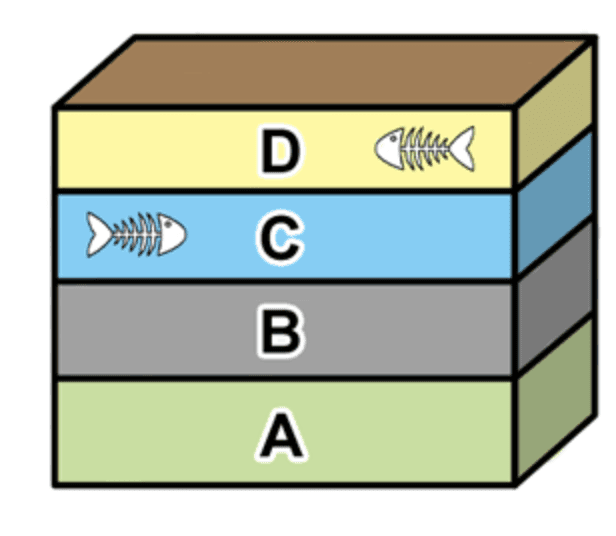
NCSCOS Grade 8 Earth Science - 8.E.2 Diagnostic Earth History
Quiz by NCDPI
Grade 8
Science
North Carolina Standard Course of Study
Feel free to use or edit a copy
includes Teacher and Student dashboards
Measures 2 skills from
Measures 2 skills from
With a free account, teachers can
- edit the questions
- save a copy for later
- start a class game
- automatically assign follow-up activities based on students’ scores
- assign as homework
- share a link with colleagues
- print as a bubble sheet
10 questions
Show answers
- Q1This diagram of strata containing fossils is MOST useful for predictingcontinental driftabsolute ageradioactive decayrelative age30s8.E.2.1
- Q2The main difference between relative dating and absolute dating is thatrelative dating gives a numerical age that is relatively close while absolute dating gives age by comparing nearby fossils.relative dating gives age compared to other nearby objects while absolute dating gives a numerical age.absolute dating always requires carbon-14 to be present in a sample while relative dating does not.relative dating requires relatives of the fossil to be living while absolute dating does not.30s8.E.2.1
- Q3What can scientists do to approximate the age of rock layers consisting mostly of sedimentary rock?Scientists cannot approximate the age of sedimentary rock layers.Scientists can date the layer of volcanic ash in between sedimentary rock layersScientists can approximate the age using ice coresScientists can date the layer of rock at the surface and assume one meter of sediment was deposited every 10,000 years.30s8.E.2.1
- Q4The hypothesis that the fossil in layer D is younger than the fossil in layer C is supported by theLaw of Relativity.Law of Gravity.Law of Thermodynamics.Law of Superposition.30s8.E.2.1
- Q5Scientists can determine the age of a layer of rock bystudying how it has been affected by erosion.comparing the size of one layer with other layers.identifying the minerals within it.examining the fossils within it.30s8.E.2.1
- Q6Found in sedimentary rocks, these fossils are hollow areas in the sediment that show the shape of an organism or part of an organism. This type of fossil is called acasttracecarbonmold30s8.E.2.2
- Q7According to the fossil record, five ________________ took place, which lowered the variety of species found on Earth today.mass extinctionsmass revolutionsmass cloiningsmicroevolution30s8.E.2.2
- Q8Fossils of a now extinct dinosaur have been found near the east coast of South America and the west coast of Africa. The dinosaur could not swim or fly. What does this suggest about the continents of South America and Africa?The continents were once connected.The same type of animals evolved on both continents.A land bridge once connected the continents.Prehistoric man transported the dinosaur between the continents.30s8.E.2.2
- Q9Fossils found in layers of sediment give us clues to Earth's past. Based on the fossil record of this area, we can assume that over millions of yearscontinents were joined togethersea level recededclimate got colderglaciers melter30s8.E.2.2
- Q10Which events are associated with transform plate boundaries?trenches and islandsvolcanoes and sea floor spreadingfolded mountainsfaults and earthquakes30s8.E.2.2
